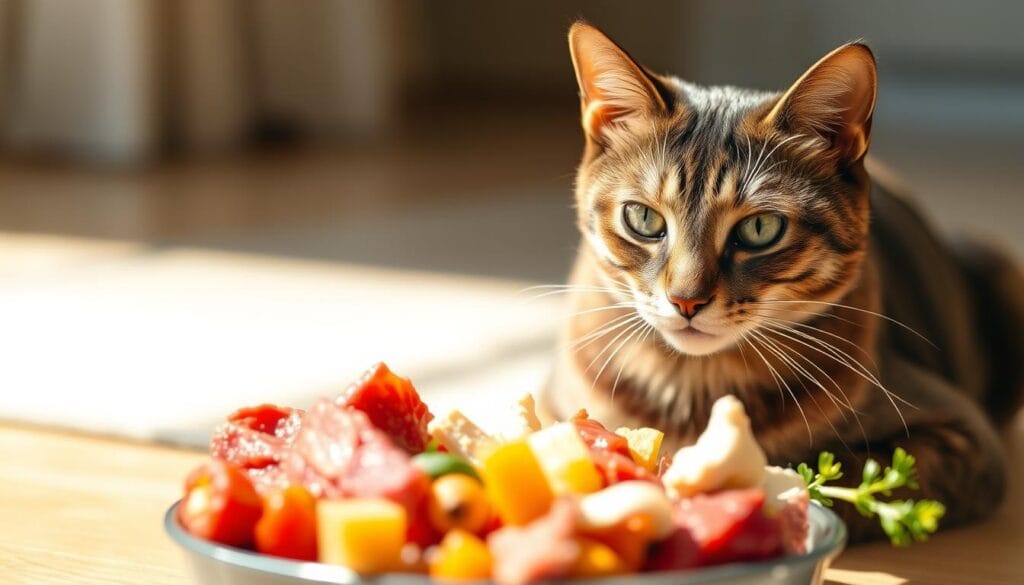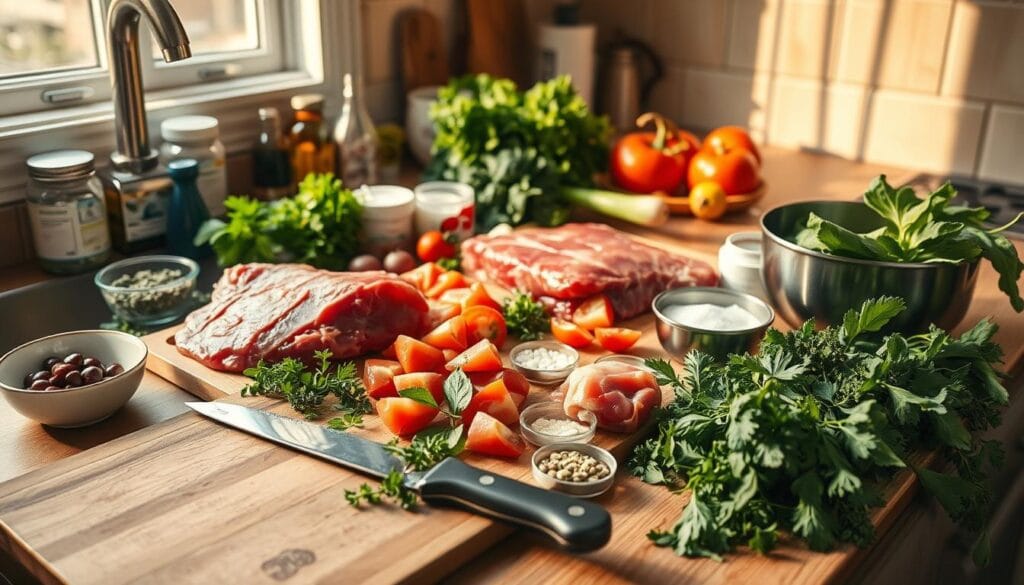Raw Food for Cats: Basic Facts and How to Prepare at Home
Have you ever wondered what your feline friend truly needs to thrive? Imagine your cat leaping with energy, their coat gleaming, their eyes bright—this is the promise of a diet that mirrors their natural instincts. Many pet parents are turning away from processed meals and embracing a simpler, ancestral way of feeding.
Table of Contents
This guide isn’t just about recipes. It’s about understanding why your carnivorous companion benefits from meals rich in muscle meat, organs, and bone. Commercial options often lack these vital nutrients, leaving pets at risk of deficiencies. By returning to basics, you’re honoring their biology.
You’ll learn how to balance nutrients safely, why hydration matters, and how to avoid common mistakes. We’ll break down the science into practical steps, so you can feel confident in every choice. Whether you’re curious or ready to start, this journey puts your cat’s well-being first.
Let’s explore how to create meals that nourish their body and spirit—just as nature intended.
Understanding the Raw Food for Cats Diet
Your feline’s biology holds the blueprint for their ideal meals. Ancestral eating patterns—not modern processing—shape what truly nourishes them. This method skips fillers and focuses on nature’s essentials.
What Is This Approach?
A raw food diet centers on uncooked animal parts like muscle meat, organs, and bones. These mirror prey your pet would hunt outdoors. Obligate carnivores thrive on high-protein, high-fat meals with almost no carbs.
Essential Building Blocks
Every meal should balance:
- 70-80% muscle meat for taurine and amino acids
- 10% bone for calcium and phosphorus
- 5% liver and 5% kidneys or spleen for vitamins A and B12
This ratio mimics wild prey, delivering nutrients commercial raw pet food often lacks. Avoid plant-heavy formulas—your companion’s system isn’t built to process grains or veggies efficiently.
Benefits of raw food for cats
Choosing meals that align with your companion’s evolutionary needs can transform their daily life. Owners often observe visible changes within weeks, from renewed vitality to physical improvements. Let’s explore how this approach supports overall wellness.

Natural Energy and Health Advantages
High-quality proteins fuel your pet’s metabolism, sparking playful behavior and sustained activity. Unlike carb-heavy options, nutrient-dense meals help maintain lean muscle mass. Many notice fewer allergy symptoms after removing processed additives and grains.
Weight management becomes simpler as meals focus on essential fats rather than fillers. This balance mimics what your feline would consume in the wild, promoting natural satiety cues.
Improved Digestion and Coat Quality
Digestive systems thrive when processing ingredients they’re designed to break down. Smaller, less smelly stools indicate efficient nutrient absorption. You’ll also see a glossier coat thanks to omega fatty acids in fresh meats.
Chewing muscle fibers and connective tissue naturally cleans teeth, reducing plaque buildup. These combined effects create a healthier, happier companion ready to leap into each day.
Choosing the Right Protein Sources and Meats
Selecting proteins for your feline’s meals requires balancing nutrition, cost, and dietary needs. Rotating sources prevents boredom and reduces allergy risks while delivering essential nutrients. Start with familiar options before exploring novel choices.
Ground chicken with bone offers an affordable entry point at $2.93 per pound. This blend provides muscle meat and calcium-rich bone in one package. For kittens or adults needing variety, mixes combining beef, chicken hearts, and liver deliver complete nutrition for under $4 per pound.
Expanding the Menu
Rabbit shines for sensitive pets, though its $7.33 price tag reflects its specialty status. Venison pairs well with beef heart at $3.77 per pound, offering rich flavor and novel proteins. These alternatives help avoid reactions caused by repeated exposure to common meats.
Weekly rotation between three to five protein types ensures broad nutrient intake. Always introduce new options gradually to monitor tolerance. Quality suppliers like Blue Ridge Beef simplify this process with pre-ground blends containing bone and organ meats.
How to Prepare a Nutritionally Balanced Raw Diet at Home
Crafting meals that meet your pet’s nutritional needs requires precision and care. Proper ratios of muscle meat, organs, and calcium sources form the foundation of a balanced diet. Let’s break down the essentials for creating safe, wholesome meals in your kitchen.

Step-by-Step Preparation Tips
Start with pre-ground meats containing 10-12% bone content, like chicken or turkey blends. These eliminate guesswork while providing necessary calcium. Follow the 80/10/5/5 ratio: 80% muscle meat, 10% edible bones, 5% liver, and 5% other organs.
Use dedicated tools—separate knives and containers—to avoid cross-contamination. Portion meals into single servings using freezer-safe bags. Thaw portions in the fridge overnight, never at room temperature.
Ensuring Safety and Hygienic Practices
Sanitize surfaces before and after prep. Wash hands thoroughly after handling meats. Store your pet’s meals in a separate freezer section away from human food.
Transition slowly by mixing 25% new meals with their current diet for 7-10 days. This helps their digestive system adapt without stress. Ground options like beef heart blends make this shift easier while maintaining nutrient balance.
Remember: consistency in ratios and cleanliness ensures every bite supports their vitality. With these steps, you’ll create meals that align with their biological needs safely and effectively.
Comparing Raw Feeding Options for Cats and Other Pets
Exploring meal plans for pets requires understanding their unique needs and your lifestyle. Modern solutions balance nutrition with practicality, letting you prioritize quality without sacrificing convenience.
Subscription Plans and Variety Packs
Subscription services simplify meal planning. Brands like Blue Ridge Beef offer flexible deliveries—weekly to quarterly—at $117 per shipment. This ensures fresh supplies arrive regularly, eliminating last-minute rushes.
Variety packs let you rotate proteins like chicken, rabbit, or venison. Dietary diversity helps prevent sensitivities while delivering broader nutrient profiles. Ideal for picky eaters or pets needing novel ingredients.
Freeze-Dried Versus Frozen Cat Food
Freeze-dried options use sublimation to remove moisture while preserving nutrients. These minimally processed meals need no thawing—just add water. Perfect for travel or busy households.
Primal raw frozen blends retain natural textures but require freezer space. They’re ideal for pets preferring authentic textures. Some formulas work for multi-pet homes, but always check species-specific needs.
| Feature | Freeze-Dried | Frozen |
|---|---|---|
| Preparation | Rehydrate in minutes | Thaw overnight |
| Shelf Life | 2 years (unopened) | 6 months (freezer) |
| Storage | Room temperature | Freezer required |
Your choice depends on routine and storage capacity. Both options outperform kibble in nutrient retention, aligning with your pet’s biological needs.
Addressing Common Myths and Concerns About Raw Feeding
Many pet owners hesitate to explore species-appropriate meals due to widespread misinformation. Let’s separate fact from fiction and address valid safety considerations.
Clearing the Air on Safety and Nutrition
Bacterial risks often top worry lists, but proper handling reduces contamination chances significantly. Use separate prep surfaces and freeze meals promptly. High-quality suppliers test ingredients rigorously, making these options safe for both dogs and cats.
Time constraints shouldn’t deter you either. Pre-mixed blends and subscription services simplify meal prep. Rotating proteins takes seconds when using pre-portioned packs.
| Myth | Fact |
|---|---|
| Bones are dangerous | Raw ground bones digest safely |
| Causes aggression | Promotes calm behavior |
| Nutritionally incomplete | Meets AAFCO standards |
| Vets oppose it | Growing professional support |
Allergy concerns fade when eliminating grains and artificial additives. Pets consuming fresh proteins often show fewer digestive issues. Always introduce new meats gradually to monitor reactions.
While some veterinarians caution against this approach, updated research confirms its benefits. Partner with a nutrition-savvy vet to create balanced plans tailored to your companion’s needs.
Final Thoughts on Your Raw Food Diet Journey
Choosing to nourish your feline with biologically appropriate meals marks a transformative shift in their care. This approach honors their natural needs as carnivores, supporting lifelong vitality through nutrient-rich ingredients. While transitioning requires dedication, the rewards—shinier coats, balanced digestion, and sustained energy—show your commitment pays off.
Preparing meals that match their nutritional needs helps avoid common health issues linked to processed options. Start slowly, monitor reactions, and consult your vet to refine the plan. Many find improved dental health and fewer allergies emerge over time.
Though initial research feels overwhelming, resources like pre-mixed blends simplify the process. Rotating proteins ensures variety while meeting dietary standards. Remember: every small step toward fresh, whole ingredients makes a difference.
This great choice reflects your desire to prioritize well-being over convenience. With patience and proper guidance, you’ll create a sustainable routine that keeps your companion thriving for years.

